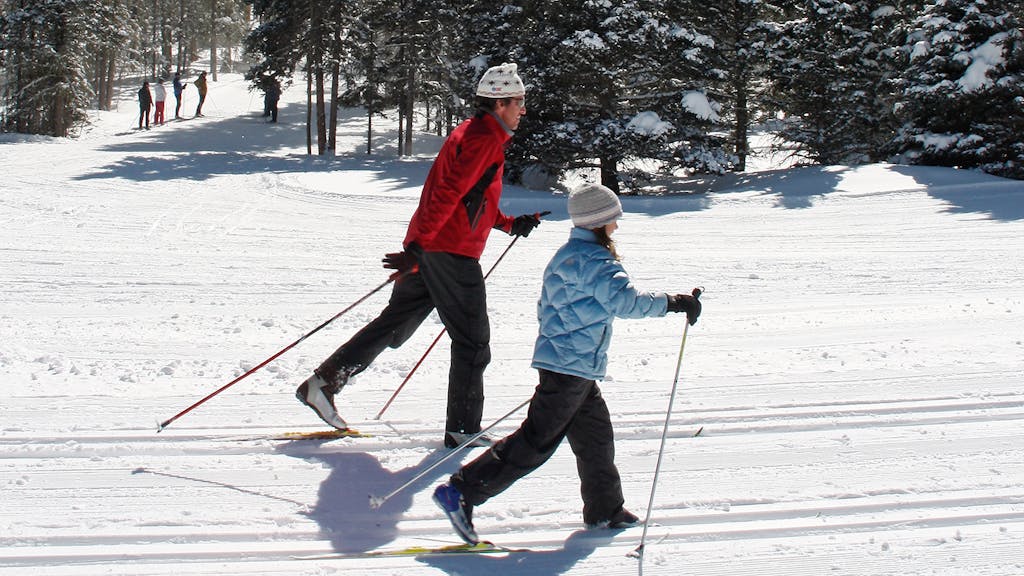Dressing For Highly Aerobic Winter Sports
The following is from National Ski Patrol and Professional Ski Instructors of America websites.
Even though the thermostat reads 15 degrees and you can see your breath, if you’re running, hiking, snowshoeing, or cross-country skiing, you can expect to heat up fast and perspire. If the sweat you produce during this workout is trapped next to your skin, you will eventually feel chilled. Not only is this cold clammy feeling uncomfortable, it can be dangerous, especially as you start to cool down. Protect yourself by wearing lightweight layers that you can remove quickly and stow away as you warm up.
Moisture management is the first consideration here. To keep the body warm during high-energy activities, clothing should transport moisture away from the skin, to the outer surface of the fabric where it can evaporate. Tall order? Fortunately companies such as Duofold are now using new ultra-light fabrics like CoolMax and Thermastat in their long underwear. These materials wick moisture from the skin and move it away, so start with this as an inner layer. Also look for garments made from the new stretch fabrics for better fit and performance.
Your next layer should be a lightweight stretchy insulator such as a breathable fleece sweater or vest. While you might not need it once you’re warmed up, you’ll appreciate a cozy top on your descent or on the ride home.
The final part of your cold-weather wear should be a lightweight and versatile shell jacket that will function for highly aerobic as well as less strenuous activities, depending on what you layer under it. With the creation of The North Face’s three-layer Gore-Tex and other innovative fabrics, today’s shells are ultra lightweight, while remaining waterproof, windproof, and breathable. Activent, a new highly breathable shell-fabric option (also by The North Face), is water-resistant, and may be a good option if weather conditions are fair and you’re really moving. For aerobic activities, a shell’s ventilating features are particularly important. Look for underarm zippers as well as venting pockets and back flaps.
Depending on the activity and weather, a lightweight wicking layer and stretch fleece pant are often all you’ll need on the bottom. In deeper snow, you can wear gaiters to protect your feet and ankles, but carry lightweight shell pants with side zips just in case the weather gets nasty.
Always bring a hat and gloves, regardless of the weather or your activity level. As with the rest of your clothing, synthetic materials work best for protecting you against the extremes–plus they don’t itch! Look for fleece hats made with Windstopper fabric; gloves and mittens layered with Gore-Tex and fleece; and socks made of synthetic, moisture-wicking materials.
Frequently Asked Questions
-
When natural fibers like cotton and wool get wet from snow or perspiration, they retain their moisture, leaving the wearer wet and chilled. Not only is this uncomfortable, it can affect performance and be potentially dangerous. When skin remains wet in a cold environment, the body’s core temperature can be lowered enough to cause hypothermia. Not only do synthetic fabrics wick moisture away from the skin, they dry quickly and help keep the wearer warm in the process.
-
Gore-Tex is actually not a fabric, it’s a membrane that is laminated to a shell fabric such as nylon or polyester. Before the mid-1970s, when Gore-Tex was invented, wearing a water- and windproof shell jacket meant sacrificing breathability. Both waterproof and breathable, Gore-Tex set a new standard for technical outerwear. Today, many outdoor clothing manufacturers offer functional alternatives to Gore-Tex, all of which provide varying degrees of waterproofing and breathability. One of these alternatives might work for you just as well or better than Gore-Tex–it’s really a matter of assessing your personal needs depending on your activity level, body type, and where you’ll be skiing, boarding, or snowshoeing.
-
For any outdoor winter activity, an inner wicking layer is crucial. Nothing will help you stay warm and comfortable as well as a garment with moisture-transport capabilities. You can purchase an inexpensive fleece insulator that will function during most activities. Look for features that add versatility, such as a snap turtleneck or full zip. An outer shell doesn’t always have to be both waterproof and breathable–you can consider more affordable alternatives that are highly water-resistant yet still breathable. Again, keep versatility and ventilation in mind. Snap-off hoods, underarm zippers, and ventilating pockets are features that add value and performance to a shell garment. A pair of full side-zip shell pants are another investment worth making. As the weather changes, you can easily put them on or take them off without removing skis or snowshoes.
-
Most outdoor manufacturers offer fleece garments in various weights for different activity levels and climates. When shopping, think hard about the type of activity you’ll do most often, and where you’ll do it, as well as how your body functions. Lightweight stretchy fleece garments are best for highly aerobic sports like cross-country skiing and running; the stretch allows arms to swing freely and makes the garment easier to add or shed. For downhill skiing and snowboarding, you might need a thicker fleece to retain warmth between runs. There are numerous fleece weights and styles to help outdoor enthusiasts find the perfect fit for their specific needs.

